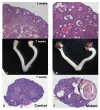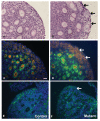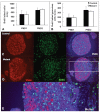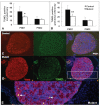Notch2 is required in somatic cells for breakdown of ovarian germ-cell nests and formation of primordial follicles
- PMID: 23406467
- PMCID: PMC3606475
- DOI: 10.1186/1741-7007-11-13
Notch2 is required in somatic cells for breakdown of ovarian germ-cell nests and formation of primordial follicles
Abstract
Background: In the mouse ovary, oocytes initially develop in clusters termed germ-cell nests. Shortly after birth, these germ-cell nests break apart, and the oocytes individually become surrounded by somatic granulosa cells to form primordial follicles. Notch signaling plays essential roles during oogenesis in Drosophila, and recent studies have suggested that Notch signaling also plays an essential role during oogenesis and ovary development in mammals. However, no in vivo loss-of-function studies have been performed to establish whether Notch family receptors have an essential physiological role during normal ovarian development in mutant mice.
Results: Female mice with conditional deletion of the Notch2 gene in somatic granulosa cells of the ovary exhibited reduced fertility, accompanied by the formation of multi-oocyte follicles, which became hemorrhagic by 7 weeks of age. Formation of multi-oocyte follicles resulted from defects in breakdown of the primordial germ-cell nests. The ovaries of the Notch2 conditional mutant mice had increased numbers of oocytes, but decreased numbers of primordial follicles. Oocyte numbers in the Notch2 conditional mutants were increased not by excess or extended cellular proliferation, but as a result of decreased oocyte apoptosis.
Conclusions: Our work demonstrates that Notch2-mediated signaling in the somatic-cell lineage of the mouse ovary regulates oocyte apoptosis non-cell autonomously, and is essential for regulating breakdown of germ-cell nests and formation of primordial follicles. This model provides a new resource for studying the developmental and physiological roles of Notch signaling during mammalian reproductive biology.
Figures







Similar articles
-
Notch signaling regulates ovarian follicle formation and coordinates follicular growth.Mol Endocrinol. 2014 Apr;28(4):499-511. doi: 10.1210/me.2013-1288. Epub 2014 Feb 19. Mol Endocrinol. 2014. PMID: 24552588 Free PMC article.
-
Estradiol, progesterone, and genistein inhibit oocyte nest breakdown and primordial follicle assembly in the neonatal mouse ovary in vitro and in vivo.Endocrinology. 2007 Aug;148(8):3580-90. doi: 10.1210/en.2007-0088. Epub 2007 Apr 19. Endocrinology. 2007. PMID: 17446182
-
The infant and pubertal human ovary: Balbiani's body-associated VASA expression, immunohistochemical detection of apoptosis-related BCL2 and BAX proteins, and DNA fragmentation.Hum Reprod. 2013 Mar;28(3):698-706. doi: 10.1093/humrep/des453. Epub 2013 Jan 12. Hum Reprod. 2013. PMID: 23315064
-
Pathways coordinating oocyte attrition and abundance during mammalian ovarian reserve establishment.Mol Reprod Dev. 2020 Aug;87(8):843-856. doi: 10.1002/mrd.23401. Epub 2020 Jul 27. Mol Reprod Dev. 2020. PMID: 32720428 Review.
-
The adult ovary at single cell resolution: an expert review.Am J Obstet Gynecol. 2025 Apr;232(4S):S95.e1-S95.e16. doi: 10.1016/j.ajog.2024.05.046. Am J Obstet Gynecol. 2025. PMID: 40253085 Review.
Cited by
-
Activation of Notch Signaling by Oocytes and Jag1 in Mouse Ovarian Granulosa Cells.Endocrinology. 2019 Dec 1;160(12):2863-2876. doi: 10.1210/en.2019-00564. Endocrinology. 2019. PMID: 31609444 Free PMC article.
-
An overview of gene expression dynamics during early ovarian folliculogenesis: specificity of follicular compartments and bi-directional dialog.BMC Genomics. 2013 Dec 19;14:904. doi: 10.1186/1471-2164-14-904. BMC Genomics. 2013. PMID: 24350644 Free PMC article.
-
Diversity of cell death pathways: insight from the fly ovary.Trends Cell Biol. 2013 Nov;23(11):567-74. doi: 10.1016/j.tcb.2013.07.005. Epub 2013 Aug 19. Trends Cell Biol. 2013. PMID: 23968895 Free PMC article. Review.
-
From primordial germ cells to primordial follicles: a review and visual representation of early ovarian development in mice.J Ovarian Res. 2016 Jun 21;9(1):36. doi: 10.1186/s13048-016-0246-7. J Ovarian Res. 2016. PMID: 27329176 Free PMC article. Review.
-
The role of oncogenic Notch2 signaling in cancer: a novel therapeutic target.Am J Cancer Res. 2019 May 1;9(5):837-854. eCollection 2019. Am J Cancer Res. 2019. PMID: 31218097 Free PMC article. Review.
References
Publication types
MeSH terms
Substances
Grants and funding
LinkOut - more resources
Full Text Sources
Other Literature Sources
Molecular Biology Databases
Miscellaneous

